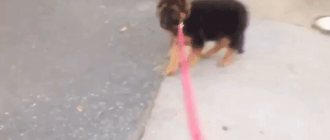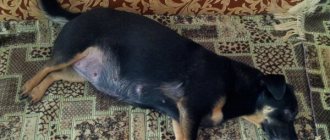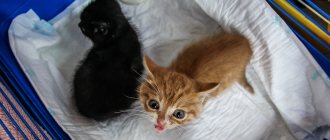Ear shape requirements
The Toy Terrier breed standards for ears are as follows:
- standing;
- vertical;
- smooth;
- large;
- thin;
- no creases;
- set high.
The Russian Longhaired Toy is allowed to have hanging, semi-erect ears, as they are weighed down by the hair. Smooth-haired Toys with floppy ears will not be able to participate in exhibitions.
Russian toy terrier
When do the ears of a toy terrier stand up, and is it worth cropping them?
A toy terrier is born with floppy ears, and with age they stand up on their own. Each puppy’s body is individual, which means it’s difficult to say exactly what time a toy terrier’s ears stand up. Typically, the cartilage of the auricle begins to thicken and support the ear from two months. You need to move on to active manipulations to install drooping ears from 4-6 months. When the puppy is one year old, there is no point in putting floppy ears.
For toys, docking is not provided. This procedure is done only in case of illness, and when the ear can no longer be saved.
Important! The older the puppy, the more difficult it is for him to fix the ear.
Yorkshire Terrier
Many dog breeders are interested in what time the ears of Yorkshire terriers stand up. Having adopted a small puppy, you should be responsible for it and carefully take care of its health from birth. Any breed of dog requires knowledge and skills. Thus, let’s try to answer the question – what time does a puppy’s ears start to stand up?
All dogs develop individually and depend not only on the breed, but also on other external and internal factors. However, according to the standards of dog handlers, the ears of a Yorkshire terrier stand up by four to five months, or after the change of baby teeth.
If the pet is already five months old, the teeth have changed, and the ears are not yet erect, then this may be affected by:
- Too big cartilages. In some dogs they develop very quickly, and external proportions are disrupted. And because of their heaviness, they cannot rise up.
- A large amount of hair weighs down the ears, so the weight prevents them from standing up.
- Lack of calcium and vitamins.
In all three cases, the situation can be corrected by gluing the ears, replenishing vitamins and cutting. The main thing is not to delay correcting the situation. It is important to remember that even a specialist cannot establish an accurate prognosis. First of all, a pet needs to be loved even with a small flaw, because it is a member of the family, and not an exhibition exhibit.
The main causes of problem ears
At what age a toy terrier's ears stand up depends on the readiness of the cartilage. For the formation of ear cartilage, a balance of calcium and other trace elements in the puppy’s body is necessary. In order for the cartilage to be ready to support the ear, it is important to properly feed both the mother during pregnancy and lactation, and the baby itself.
By two months, the puppy’s diet should contain appropriate supplements in the form of ready-made complexes of vitamins and minerals. Or if the puppy’s food is natural, you need to give him calcined cottage cheese. You can prepare it yourself or purchase it.
Calcined cottage cheese
When a Toy Terrier's ears stand up, they may fall down again. This happens when there is a lack of calcium in the body during teeth changing. As soon as there is enough calcium in the diet, the problem will solve itself. But there will still be a strip at the fold. This dog is no longer suitable for exhibition.
Why ears may droop
Several reasons why a toy terrier's ear has fallen off:
- stress;
- change of environment and place of residence;
- sudden change in diet;
- illness and weak immunity.
Another reason why the toy terrier does not have erect ears is the crossing of smooth-haired and long-haired toy terriers. This situation is ambiguous. Sometimes the ears will stand up, for example, if the mother had little hair on her ears and the cartilage was well formed.
Why don't my ears stand up?
For some owners of this breed, it is the ear problem that becomes urgent.
They don't rise for many reasons, but here are the main ones:
- The puppy’s parents had problems with the formation of ear cartilage;
- the baby did not receive sufficient nutrition from the mother in infancy;
- the breeder did not provide the grown puppy with food rich in all the necessary vitamins, i.e. he eats an unbalanced diet;
- the puppy was obtained by mating a long-haired and a short-haired toy terrier;
- calcium deficiency;
- various injuries of the auricle at birth or later;
- stressful situations
NOTE!
If you are afraid that your dog’s ear will not stand up, although you are confident in his health and in the health of his parents, then after consulting with a veterinarian, start giving him vitamin supplements.
What to do if your dog's ears don't stand up
The health of the future puppy should be established in the womb. Therefore, if possible, it is worth monitoring the bitch’s diet during pregnancy and nursing. The mother's diet should be enriched with vitamins and minerals for the development of healthy babies.
The metabolic processes of a small puppy must proceed correctly, the dog must be healthy. And here it is not only calcium and the right amount that is important. A small puppy must undergo all necessary vaccinations and examination by a veterinarian.
How to raise your ears correctly
Proper raising of a toy terrier's ears is a natural process that occurs without external intervention. You can strengthen the cartilage and prepare it for loading with the help of massage. It must be done regularly, starting from two months. The thumb should be placed on the cartilage inside the auricle, and the index finger on the outside of the ear. Massaging light movements should go from bottom to top. The little naughty boy will really like this massage.
Ear patching for toy terriers
Natural processes in the body should be corrected when the owner is sure that the ear will not stand up on its own. By 4-6 months, you can begin to correct the position of the ears using splint adhesives. Many experienced breeders claim that the sooner this procedure is started, the faster and more likely the ears will become.
It is very important that this procedure does not cause discomfort to the pet. Of course, at first he will try to get rid of the Velcro on his ears. In these cases, it is necessary to distract the baby with games, walks, and affection.
Ear placement using splints
In the first days, gluing should be done under supervision. At night, it is better to remove the adhesive plaster. The dog may hurt itself and scratch its head in an attempt to get rid of it. In just 3-4 days, the puppy will get used to the stickers and will stop paying attention to them.
Another important point is the design itself on the dog. Only adhesive tape should be used. Its material is breathable and does not cause irritation to the Toy Terrier's skin. The material from which the tires will be made should not be harsh or heavy. It is better to use cardboard, wooden skewers or cotton swabs.
Note! Scotch tape, film or tape can cause allergic reactions and skin irritation. It is dangerous to use them to set the ears.
Step-by-step instruction
One of the reliable and proven options is to set the ears of a toy terrier using cotton swabs. They should be freed from the soft tips and tried on the ear. To calculate the length of the tire sticks, you need to start measuring by stepping back half a centimeter from the pointed tip and adding a little after the fold line. Next, you should make one square of adhesive plaster, 2 cm wide and long, equal to the length of the finished tires. Two more pieces of adhesive plaster should be cut slightly shorter in length.
Step by step procedure:
- Place a large square of adhesive tape on the inside of the ear. It must necessarily capture the fold line with a gap.
- Secure the sticks to the ear with a second piece of adhesive tape.
- Secure the structure with the last square of adhesive tape.
This procedure will have to be done more than once for the little fidget. You shouldn't expect quick results. Ear placement using correction lasts from two to eight weeks.
Important! When correcting the position of the ears, you need to do a toya massage to strengthen the cartilage.
Correcting incorrectly placed ears
When the position is corrected with the help of splints, it often happens that the ears that are set too far do not rise. The natural process of placement involves raising the auricle above the head, and not from its sides.
Wide-set ears
An adhesive plaster will again help correct this situation. You need to take the ear by the tip and twist it into a tube according to the length of the turn. That is, clockwise if the ear is left, and counterclockwise if the ear is right. You need to wrap several layers of adhesive tape around the twisted tube, not reaching the base of the sink. The design should be updated every 3-4 days. It all depends on the pet’s desire to get rid of the sticky tape. Once every two weeks you need to give your toy terrier a “day off” and free his ears for the whole day.
On a note! With the help of this adjustment, the auricle becomes in the right place within 2-6 weeks.
It is easy to install ears on a toy terrier. An important condition for a successful formulation is to cover issues of development, nutrition, sufficient nutrients and vitamins, and cartilage formation. If you approach solving the problem comprehensively, your toy terrier’s ears will stand up without any problems or unnecessary manipulations.
At what age do Chihuahua ears stand up?
If, upon reaching the designated age, the ears are still falling, then the breeders perform gluing, which allows them to be placed vertically, then by two to three months the baby can already move the erect ears with an oar.
When do terriers' ears stand up?
“A Puppy Enters the House” by Brigitte Harris, published in Cosmos - Verlag.
Little guide for the first time with your new family member. This book is also easy to read for children. A funny book about dog training, with comic style drawings galore, entertaining and fun to read. The book makes you smile and is very interesting. The key to successful dog training. These two books complement each other perfectly. They show new ways of motivation and positive reinforcement. The dog's natural adaptations are guided in the right direction. The Right Dog for My Child by Marion von Shaywick. This book is suitable for families who are still looking for the right race.
The description of the breed standard states that the ears should be large, clearly erect, wide at the base, gradually tapering and rounded at the tip.
The main causes of problem ears
Creases form when the ear cartilage is weak. In the long-haired type of Chihuahua, due to the weight of the ears with long outer hair, soft ears are more common.
How to clean the ears of a toy terrier
It is also very worth reading a blank study book. Both authors also wrote a book: "Kindergarten Puppy" as Cosmos - Verlag. For processing a puppy. "A Wolf in Sheep's Clothing" by Günther Bloch, Westkreuz-Verlag. Dog training from a different point of view, flexible, animal psychological training of dogs without violence.
How to put ears on a toy terrier
"The Secret Life of Dogs" by Elizabeth Marshall Thomas, Rolokhlit Taschenbuch Verlag. A behavioral scientist shares the fascinating story of his dogs. This book belongs in every home where a dog lives. Conflict-free education for a family dog. Both books complement each other perfectly.
During the change of teeth, negative processes can also occur in the ears. Moreover, before that the ear can stand well, after that the cartilage becomes stronger again, but the creases remain forever.
Methods for correcting ear defects
Depending on the cause, it is necessary to select different options for restoring protruding ears. With timely intervention, major troubles can be avoided.
Devote a lot of time to your new family member in the first weeks and months and treat him with love. Let him participate in your life and communicate with him. It will be worth it and your little friend will thank you for the rest of his life. Irish Terrier puppies from Acacia Grove offer the best conditions for this. “Praise should be obvious to the owner, because the Irish Terrier does everything out of love for his owner, for the joy of praise, and not from coercion.” The owner is responsible for the development and obedience of his dog.
ear splint (you can use a match, a toothpick, the refill of a ballpoint pen), the main thing is that it is light and slightly shorter than the ear.
measure the linear parameters of the ear to cut two petals from the plaster of the same size. The length of the petals should be slightly smaller than the puppy’s ear, but repeat its shape;
Preventive measures
It must contain products with calcium: cottage cheese, special calcined vitamin supplements.
He must prevent the Irish Terrier puppy from later focusing on the habits and habits of his owner, and he will naturally go the right way, but he needs the constant closeness and love of his owner; he has unrivaled adaptability.
For all other questions about posture and education, we are happy to help and advise! The Boston Terrier is a charming, friendly and uncomplicated four-legged friend that is also very suitable for inexperienced dog owners. Thanks to its compact appearance, it is captivating more and more animal lovers.
Also massage your ears regularly with your fingers. About six times a day. It perfectly stimulates blood circulation.
The thumb is on the outside of the ear, and the index and middle fingers are on the inside. It is especially effective to perform it in places of fracture. But not with pulling movements, but with stroking movements.
Walking in the fresh air
Body and face of the Boston Terrier
Boston Terriers have a short coat
Boston Terriers are sensitive to weather conditions. Boston Terrier: health and nutrition. Boston Terrier: origin and distribution. The Cairn Terrier is a small dog breed and impresses with its small, pointed ears and full coat, which can come in a variety of colors. The typical breed is a slightly advanced prone posture. The Cairn Terrier is a small dog that reaches a height of about 30 cm at the withers and weighs up to 7.5 kilograms. The Cairn Terrier is a compact quadruped with a particularly weatherproof coat.











